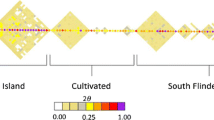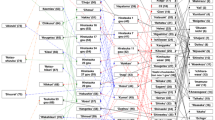Abstract
Nine microsatellite DNA markers (simple sequence repeats, SSRs) were used to estimate pairwise relationships among 597 Scots pine (Pinus sylvestris) trees as well as to generate a sibship structure for quantitative genetic parameters’ estimation comparison. The studied trees were part of an open-pollinated progeny test of 102 first-generation parents. Three methods were used to estimate variance components and heritabilities, namely, structured pedigree (half- and full-sib), marker-based pairwise relationships (four pairwise estimators), and a combined pedigree and marker-based relationship. In each of the three methods, the same animal model was used to compute variances except when marker-based relationship was used wherein we substituted the average numerator relationship matrix (i.e., pedigree-based matrix) with that computed based on markers’ pairwise relationships. Our results showed a high correlation in estimated breeding values between the pedigree (full-sib) and the combined marker-pedigree estimates. The marker-based relationship method produced high correlations when individual site data were analyzed. In contrast, the marker-based relationship method resulted in a significant decrease in both variance estimation and their standard errors which were in concordance with earlier published results; however, no estimates were produced when across-site analyses were attempted. We concluded that the combined pedigree method is the best approach as it represents the historical (pairwise) and contemporary (pedigree) relationships among the tested individuals, a situation that cannot be attained by any of the used methods individually. This method is dependent on the number and informativeness of the markers used.

Similar content being viewed by others
References
Askew GR, El-Kassaby YA (1994) Estimation of relationship coefficients among progeny derived from wind pollinated orchard seeds. Theor Appl Genet 88:267–272
Auckland LD, Bui T, Zhou Y, Shepherd M, Williams CG (2002) Conifer microsatellite handbook. Corporate, Raleigh
Bink MCAM, Anderson AD, van de Weg WE, Thompson EA (2008) Comparison of marker-based pairwise relatedness estimators on a pedigreed plant population. Theor Appl Genet 117:843–855
Blonk RJW, Komen H, Kamstra A, van Arendonk JAM (2010) Estimating breeding values with molecular relatedness and reconstructed pedigrees in natural mating populations of common sole, Solea solea. Genetics 184:213–219
Botstein D, White RL, Skolnick M, Davis RW (1980) Construction of a genetic-linkage map in man using restriction fragment length polymorphisms. Am J Hum Genet 32:314–331
Burczyk J (1998) Mating system variation in a Scots pine clonal seed orchard. Silvae Genetica 47:155–158
Bömcke E, Gengler N (2009) Combining microsatellite and pedigree data to estimate relationships among Skyros ponies. J Appl Genet 50:133–143
Caballero A, Toro MA (2000) Interrelations between effective population size and other pedigree tools for the management of conserved populations. Genet Res 75:331–343
Cappa EP, Lstiburek M, Yanchuk AD, El-Kassaby YA (2011) Two-dimensional penalized splines via Gibbs sampling to account for spatial variability in forest genetic trials with small amount of information available. Silvae Genetica 60:25–35
Cheng SH, Higham NJ (1998) A modified Cholesky algorithm based on a symmetric indefinite factorization. Siam J on Matrix Anal and Appl 19:1097–1110
El-Kassaby YA, Lstibůrek M (2009) Breeding without breeding. Genet Res 91:111–120
El-Kassaby YA, Cappa EP, Liewlaksaneeyanawin C, Klápště J, Lstibůrek M (2011) Breeding without breeding: is a complete pedigree necessary for efficient breeding? PLoS One 6:e25737. doi:10.1371/journal.pone.0025737
Falconer DS, Mackay TFC (1996) Introduction to quantitative genetics, 4th edn. Longman, London
Frentiu FD, Clegg SM, Chittock J, Burke T, Blows MW, Owens IPF (2008) Pedigree-free animal models: the relatedness matrix reloaded. Proc of the Royal Soc B-Biol Sci 275:639–647
Gilmour AR, Thompson R, Cullis BR (1995) Average information REML, an efficient algorithm for variance parameter estimation in linear mixed models. Biometrics 51:1440–1450
Gilmour AR, Cullis BR, Welham SI, Thompson R (2002) ASReml reference manual. NSW Agriculture, Australia
Hardy OJ, Vekemans X (2002) SPAGEDi: a versatile computer program to analyse spatial genetic structure at the individual or population levels. Mol Ecol Notes 2:618–620
Higham NJ (2002) Computing the nearest correlation matrix—a problem from finance. IMA J Numer Anal 22:329–343
Huby M, Griffon L, Moureaux S, De Rochambeau H, Danchin-Burge C, Verrier E (2003) Genetic variability of six French meat sheep breeds in relation to their genetic management. Genet Sel Evol 35:637–655
Jones OR, Wang JL (2010) COLONY: a program for parentage and sibship inference from multilocus genotype data. Mol Ecol Resour 10:551–555
Kalinowski ST, Taper ML, Marshall TC (2007) Revising how the computer program CERVUS accommodates genotyping error increases success in paternity assignment. Mol Ecol 16:1099–1106
Kaňák J, Klápště J, Lstibůrek M (2009) Úvodní genetické hodnocení semenných sadů borovice lesní v západních Čechách (Initial evaluation of seed orchards of Scots pine in the western Czech Republic). Zprávy lesnického výzkumu (Reports of Forestry Res) 3:189–204
Knol DL, Tenberge JMF (1989) Least-squares approximation of an improper correlation matrix by a proper one. Psychometrika 54:53–61
Kruuk LEB (2004) Estimating genetic parameters in natural populations using the ‘animal model’. Philos Trans of the Royal Soc of London Series B-Biol Sci 359:873–890
Li CC, Weeks DE, Chakravarti A (1993) Similarity of DNA fingerprints due to chance and relatedness. Hum Hered 43:45–52
Liewlaksaneeyanawin C, Ritland CE, El-Kassaby YA, Ritland K (2004) Single-copy, species-transferable microsatellite markers developed from loblolly pine ESTs. Theor Appl Genet 109:361–369
Lynch M, Ritland K (1999) Estimation of pairwise relatedness with molecular markers. Genetics 152:1753–1766
Malécot G (1948) Les mathematiques de I´heredite. Masson & Cie, Paris
Namkoong G, Kang HC, Brouard JS (1988) Tree breeding: principles and strategies. Springer, New York
Nejati-Javaremi A, Smith C, Gibson JP (1997) Effect of total allelic relationship on accuracy of evaluation and response to selection. J Anim Sci 75:1738–1745
Oliehock PA, Windig JJ, van Arendonk JAM, Bijma P (2006) Estimating relatedness between individuals in general populations with a focus on their use in conservation programs. Genetics 173:483–496
Porth I, Klápště J, Skyba O, Lai BSK, Geraldes A, Muchero W, Tuskan GA, Douglas CJ, El-Kassaby YA, Mansfield SD (2013) Populus trichocarpa cell wall chemistry and ultrastructure trait variation, genetic control, and genetic correlations. New Phytol 197:777–790
Powell JE, Visscher PM, Goddard ME (2010) Reconciling the analysis of IBD and IBS in complex trait studies. Nat Rev Genetics 11:800–805
Queller DC, Goodnight KF (1989) Estimating relatedness using genetic markers. Evolution 43:258–275
Rodriguez-Ramilo ST, Toro MA, Caballero A, Fernandez J (2007) The accuracy of heritability estimator using molecular information. Conserv Genet 8:1189–1198
Soranzo N, Provan J, Powell W (1998) Characterization of microsatellite loci in Pinus sylvestris L. Mol Ecol 7:1260–1261
Squillace AE (1974) Average genetic correlations among offspring from open-pollinated forest trees. Silvae Genetica 23:149–156
Visscher PM, Medland SE, Ferreira MAR, Morley KI, Zhu G, Cornes BK, Montgomery GW, Martin NG (2006) Assumption-free estimation of heritability from genome-wide identity-by-descent sharing between full siblings. PLoS Genetics 2:e41
Wang JL (2002) An estimator for pairwise relatedness using molecular markers. Genetics 160:1203–1215
White TL, Adams WT, Neale DB (2007) Forest genetics. CABI, Cambridge
Wright S (1922) Coefficients of inbreeding and relationship. Am Nat 56:330–338
Wright S, McPhee HC (1925) An approximate method of calculating coefficients of inbreeding and relationship from livestock pedigrees. J Agric Res 31:377–383
Acknowledgments
We would like to thank to T. Funda for his help with the selection of Scots pine primers. Funds from the NAZV (research grants no. QH81172 and QH81160) and the TAČR (grant no. TA01020512) to M. Lstibůrek and J. Kobliha and from the Natural Sciences and Engineering Research Council of Canada, Industrial Applied Forest Genetics and Biotechnology to Y. A. El-Kassaby, and partial support provided by USDA Forest Service, Southern Research Station through Cooperative Agreement SRS-05-IC-11330126-234 are hugely appreciated.
Author information
Authors and Affiliations
Corresponding author
Additional information
Communicated by Y. Tsumura
Electronic supplementary material
Below is the link to the electronic supplementary material.
Supplement 1
Information pertaining to the PIC (Polymorphic Information Content) per SSR locus across the nine loci. (DOC 32 kb)
Supplement 2
Assignments of 597 individuals Scots pine into 30 maternal/maternal trees. Figure was generated by software COLONY (Jones and Wang 2010) (DOC 304 kb)
Rights and permissions
About this article
Cite this article
Korecký, J., Klápště, J., Lstibůrek, M. et al. Comparison of genetic parameters from marker-based relationship, sibship, and combined models in Scots pine multi-site open-pollinated tests. Tree Genetics & Genomes 9, 1227–1235 (2013). https://doi.org/10.1007/s11295-013-0630-z
Received:
Revised:
Accepted:
Published:
Issue Date:
DOI: https://doi.org/10.1007/s11295-013-0630-z




